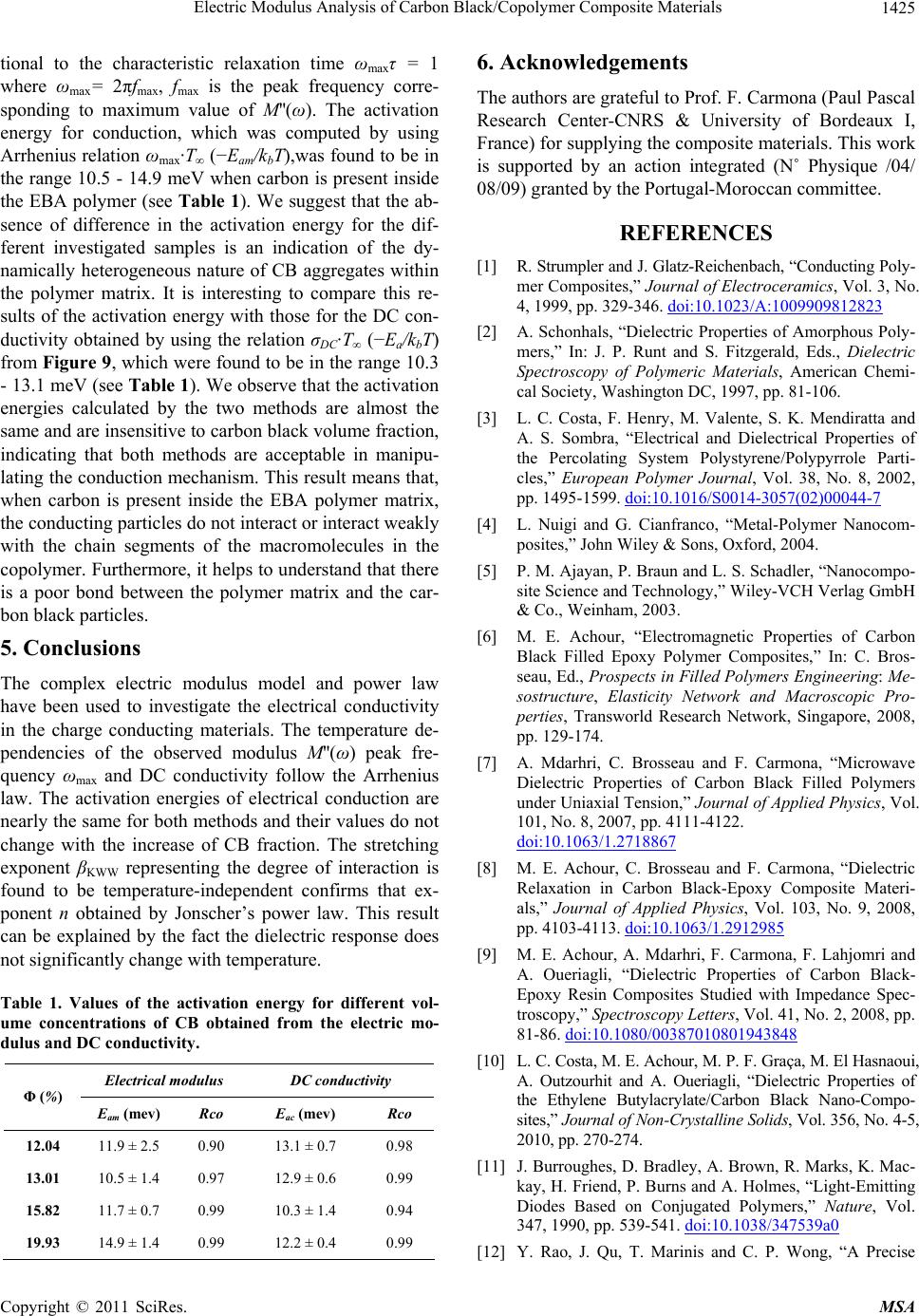
Electric Modulus Analysis of Carbon Black/Copolymer Composite Materials1425
tional to the characteristic relaxation time ωmaxτ = 1
where ωmax= 2πfmax, fmax is the peak frequency corre-
sponding to maximum value of M''(ω). The activation
energy for conduction, which was computed by using
Arrhenius relation ωmax·T∞ (−Eam/kbT),was found to be in
the range 10.5 - 14.9 meV when carbon is present inside
the EBA polymer (see Table 1). We suggest that the ab-
sence of difference in the activation energy for the dif-
ferent investigated samples is an indication of the dy-
namically heterogeneous nature of CB aggregates within
the polymer matrix. It is interesting to compare this re-
sults of the activation energy with those for the DC con-
ductivity obtained by using the relation σDC·T∞ (−Ea/kbT)
from Figure 9, which were found to be in the range 10.3
- 13.1 meV (see Table 1). We observe that the activation
energies calculated by the two methods are almost the
same and are insensitive to carbon black volume fraction,
indicating that both methods are acceptable in manipu-
lating the conduction mechanism. This result means that,
when carbon is present inside the EBA polymer matrix,
the conducting particles do not interact or interact weakly
with the chain segments of the macromolecules in the
copolymer. Furthermore, it helps to understand that there
is a poor bond between the polymer matrix and the car-
bon black particles.
5. Conclusions
The complex electric modulus model and power law
have been used to investigate the electrical conductivity
in the charge conducting materials. The temperature de-
pendencies of the observed modulus M''(ω) peak fre-
quency ωmax and DC conductivity follow the Arrhenius
law. The activation energies of electrical conduction are
nearly the same for both methods and their values do not
change with the increase of CB fraction. The stretching
exponent βKWW representing the degree of interaction is
found to be temperature-independent confirms that ex-
ponent n obtained by Jonscher’s power law. This result
can be explained by the fact the dielectric response does
not significantly change with temperature.
Table 1. Values of the activation energy for different vol-
ume concentrations of CB obtained from the electric mo-
dulus and DC conductivity.
Electrical modulus DC conductivity
Φ (%)
Eam (mev) Rco Eac (mev) Rco
12.04 11.9 ± 2.5 0.90 13.1 ± 0.7 0.98
13.01 10.5 ± 1.4 0.97 12.9 ± 0.6 0.99
15.82 11.7 ± 0.7 0.99 10.3 ± 1.4 0.94
19.93 14.9 ± 1.4 0.99 12.2 ± 0.4 0.99
6. Acknowledgements
The authors are grateful to Prof. F. Carmona (Paul Pascal
Research Center-CNRS & University of Bordeaux I,
France) for supplying the composite materials. This work
is supported by an action integrated (N˚ Physique /04/
08/09) granted by the Portugal-Moroccan committee.
REFERENCES
[1] R. Strumpler and J. Glatz-Reichenbach, “Conducting Poly-
mer Composites,” Journal of Electroceramics, Vol. 3, No.
4, 1999, pp. 329-346. doi:10.1023/A:1009909812823
[2] A. Schonhals, “Dielectric Properties of Amorphous Poly-
mers,” In: J. P. Runt and S. Fitzgerald, Eds., Dielectric
Spectroscopy of Polymeric Materials, American Chemi-
cal Society, Washington DC, 1997, pp. 81-106.
[3] L. C. Costa, F. Henry, M. Valente, S. K. Mendiratta and
A. S. Sombra, “Electrical and Dielectrical Properties of
the Percolating System Polystyrene/Polypyrrole Parti-
cles,” European Polymer Journal, Vol. 38, No. 8, 2002,
pp. 1495-1599. doi:10.1016/S0014-3057(02)00044-7
[4] L. Nuigi and G. Cianfranco, “Metal-Polymer Nanocom-
posites,” John Wiley & Sons, Oxford, 2004.
[5] P. M. Ajayan, P. Braun and L. S. Schadler, “Nanocompo-
site Science and Technology,” Wiley-VCH Verlag GmbH
& Co., Weinham, 2003.
[6] M. E. Achour, “Electromagnetic Properties of Carbon
Black Filled Epoxy Polymer Composites,” In: C. Bros-
seau, Ed., Prospects in Filled Polymers Engineering: Me-
sostructure, Elasticity Network and Macroscopic Pro-
perties, Transworld Research Network, Singapore, 2008,
pp. 129-174.
[7] A. Mdarhri, C. Brosseau and F. Carmona, “Microwave
Dielectric Properties of Carbon Black Filled Polymers
under Uniaxial Tension,” Journal of Applied Physics, Vol.
101, No. 8, 2007, pp. 4111-4122.
doi:10.1063/1.2718867
[8] M. E. Achour, C. Brosseau and F. Carmona, “Dielectric
Relaxation in Carbon Black-Epoxy Composite Materi-
als,” Journal of Applied Physics, Vol. 103, No. 9, 2008,
pp. 4103-4113. doi:10.1063/1.2912985
[9] M. E. Achour, A. Mdarhri, F. Carmona, F. Lahjomri and
A. Oueriagli, “Dielectric Properties of Carbon Black-
Epoxy Resin Composites Studied with Impedance Spec-
troscopy,” Spectroscopy Letters, Vol. 41, No. 2, 2008, pp.
81-86. doi:10.1080/00387010801943848
[10] L. C. Costa, M. E. Achour, M. P. F. Graça, M. El Hasnaoui,
A. Outzourhit and A. Oueriagli, “Dielectric Properties of
the Ethylene Butylacrylate/Carbon Black Nano-Compo-
sites,” Journal of Non-Crystalline Solids, Vol. 356, No. 4-5,
2010, pp. 270-274.
[11] J. Burroughes, D. Bradley, A. Brown, R. Marks, K. Mac-
kay, H. Friend, P. Burns and A. Holmes, “Light-Emitting
Diodes Based on Conjugated Polymers,” Nature, Vol.
347, 1990, pp. 539-541. doi:10.1038/347539a0
[12] Y. Rao, J. Qu, T. Marinis and C. P. Wong, “A Precise
Copyright © 2011 SciRes. MSA